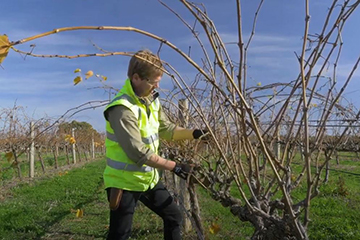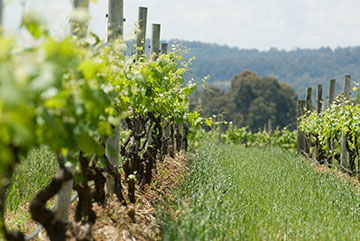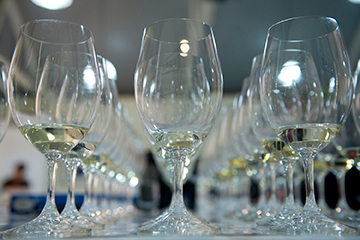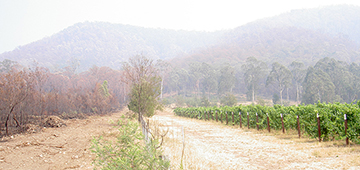The 2020/21 edition of Agrochemicals registered for use in Australian viticulture (the ‘Dog book’) is now available. The updated ‘Dog book’ can be viewed via the online pdf. A hard copy has recently been distributed to levy payers by mail and will also be included with the next issue of Australian & New Zealand Grapegrower & Winemaker.
To continue to receive a hard copy of the ‘Dog book’ in the mail each year, please provide your contact details to the AWRI at http://www.awri.com.au/dog-book or scan this QR Code:

This agrochemical update summarises the major changes in the 2020/21 ‘Dog book’ compared with the previous version.
New active constituents
The Australian Pesticides and Veterinary Medicines Authority (APVMA) has recently approved the use of the following active constituents in wine-grape production.
ACETAMIPRID AND PYRIPROXYFEN
APVMA 80807
‘Trivor’ is an Adama Australia Pty Ltd product registered for control of grapevine scale, light brown apple moth and long tailed mealybug in grapevines. It is an activity group 4A + 7C insecticide.
Recommended restriction on use (withholding period) for grapes destined for export wine: Use no later than E-L 19, about 16 leaves separated; beginning of flowering (first flower caps loosening). Limit the use of ‘Trivor’ to one application per season.
GLYPHOSATE: POTASSIUM, MONOMETHYLAMINE, MONO-AMMONIUM SALT
APVMA 86761
‘Crucial’ is a Nufarm Australia Pty Ltd product, registered for control of a range of weed species in vineyards. It is a group M herbicide.
Recommended restriction on use (withholding period) for grapes destined for export wine: Contact your winery prior to any herbicide application within 30 days of harvest.
MEFENTRIFLUCONAZOLE
APVMA 84344
‘Belanty’ is a BASF Australia Ltd product, registered for control of powdery mildew in grapevines. It is an activity group 3 fungicide.
Resistance management: Apply no more than two consecutive sprays of Group 3 fungicides per season, and no more than three in total per season. Use a fungicide of a different mode of action should further applications be required.
Recommended restriction on use (withholding period) for grapes destined for export wine: Use no later than E-L 31, berries pea-size (not > 7 mm diameter).
POTASSIUM BICARBONATE AND POTASSIUM SILICATE
APVMA 83204
‘EcoCarb Plus’ is an Organic Crop Protectants Pty Ltd product registered for control of powdery mildew and suppression of downy mildew in grapevines. It is an activity group M2 fungicide.
Recommended restriction on use (withholding period) for grapes destined for export wine: Use no later than 7 days before harvest.
Active constituent removed
The following active constituent has been removed from the ‘Dog book’ because it is no longer registered for use on grapes.
METHIDATION
Activity group 1B insecticide, registered for a range of insect pests.
Changes to withholding period (WHP) recommendations for export wine
The restriction on use for products containing mancozeb is now ‘Use no later than E-L 31, berries pea-size (not > 7 mm diameter)’.
Limits applied to number of sprays for some fungicides
GROUP M3: MANCOZEB, METIRAM, PROPINEB, THIRAM, ZINEB and ZIRAM
The recommended number of sprays of Group M3 fungicides is now limited to no more than three sprays per season. The fungal targets for the M3 fungicides include black spot, downy mildew and phomopsis cane and leaf spot.
Note that the limit of three sprays per season includes when Group M3 fungicides are co-formulated with other active constituents such as metalaxyl (-M).
CHLOROTHALONIL
The number of sprays of products containing chlorothalonil is now limited to no more than three sprays per season. The fungal targets for chlorothalonil are black spot, botrytis bunch rot and downy mildew.
CYPRODINIL
The number of sprays of products containing cyprodinil is limited to no more than one spray per season. The fungal target for cyprodinil is botrytis bunch rot.
Chemical resistance management strategies
CropLife Australia resistance management strategies and resistance information specific to botrytis bunch rot, downy mildew and powdery mildew are provided on pages 15 to 18.
Actin disruptors (aryl-phenyl-ketone) are now classed as Group 50, formally Group U8. The Group 50 fungicides are metrafenone (Vivando) and pyriofenone (Kusabi).
Correction
The maximum number of sprays per season of Group 3 and Group 5 fungicides is two. The table on page 18 of the ‘Dog book’ incorrectly states three.
Table of registered products
Products/active constituents that are underlined in the tables of registered products (pages 20 – 26), are those that are restricted for use by some wineries/grape buyers. It is recommended that prior to the use of any underlined product, growers should contact their winery or grape purchaser.
For more information or to request a copy of the new ‘Dog book’, please contact Marcel Essling on 08 8313 6600 or email helpdesk@awri.com.au.
This information is provided to inform the Australian grape and wine sector and should not be interpreted as an endorsement of any product.







